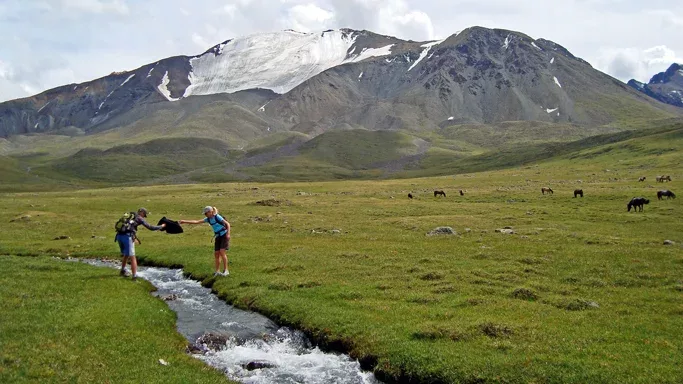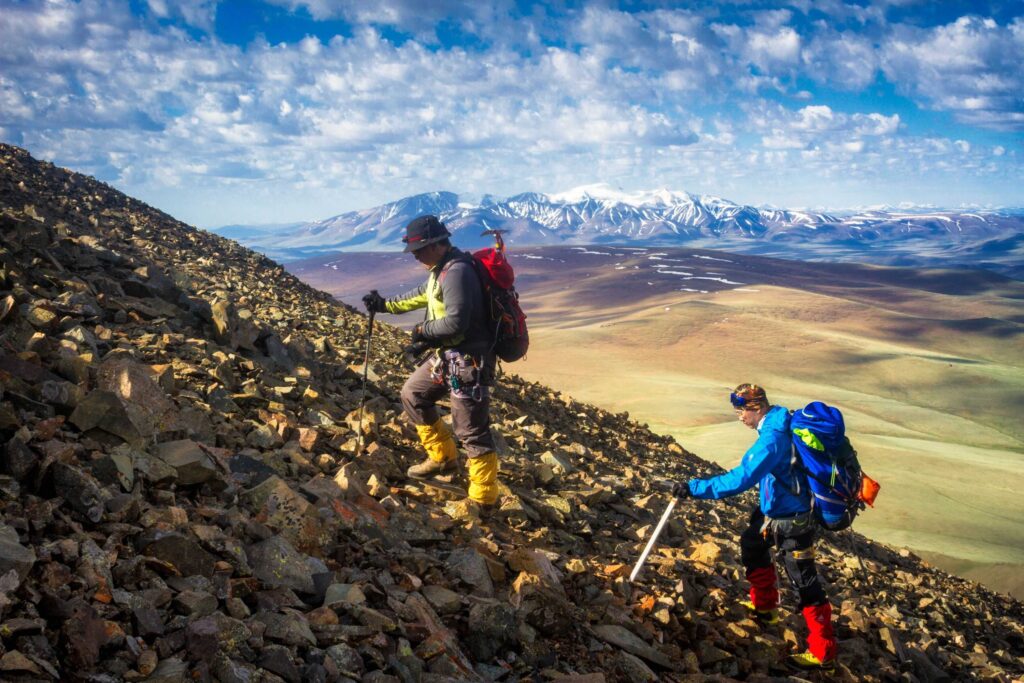Introduction
Mongolia is one of the world’s last frontiers for hiking and trekking adventures. With its vast open steppe, dramatic mountain ranges, pristine lakes, and mystical deserts, the country offers landscapes that remain almost completely untouched by mass tourism. Here, trails are not crowded with hikers, and every journey feels like a step into the unknown. For travelers seeking pure wilderness and authentic encounters, hiking in Mongolia is unlike anywhere else on Earth.

What makes Mongolia so unique for trekking is the combination of its breathtaking nature and living nomadic culture. As you cross rolling grasslands, glacial valleys, or the dunes of the Gobi Desert, you may encounter herders on horseback or families moving with their livestock, just as they have for centuries. This blending of natural beauty and cultural heritage creates a journey that is both adventurous and deeply meaningful.
Whether you dream of summiting snow-capped peaks, camping by turquoise alpine lakes, or riding alongside nomads, trekking in Mongolia promises an unforgettable experience. It’s more than just an outdoor adventure—it’s a chance to connect with a land that still feels raw, wild, and infinite. For those in search of freedom, challenge, and discovery, Mongolia truly is the ultimate destination for adventure travel.
Top Trekking Routes in Mongolia
a) Altai Tavan Bogd Trek
Located in the far west of the country, the Altai Tavan Bogd trek is one of the most spectacular Mongolia hiking trails. This route takes adventurers through snow-capped peaks, vast glaciers, and alpine valleys where eagles soar overhead. The region is also home to diverse ethnic groups such as the Kazakh people, who are famous for their tradition of eagle hunting. Trekking here is not just about natural beauty—it’s also a cultural journey into one of Mongolia’s most remote and fascinating regions.
b) Khovsgol Lake & Darkhad Valley Trek
Known as the “Blue Pearl of Mongolia,” Khovsgol Lake is one of the largest and purest freshwater lakes in Asia. Surrounded by lush forests and rolling mountains, it provides an ideal setting for multi-day treks. Extending into the Darkhad Valley, hikers encounter pristine rivers, wildflowers, and the mystical taiga landscape. This Khovsgol Lake trek is perfect for those who want to combine scenic nature with opportunities for trekking in Mongolia that feels remote yet accessible.
c) Orkhon Valley Trek
A UNESCO World Heritage Site, the Orkhon Valley trekking route combines stunning nature with deep history. This area is often considered the cradle of Mongolian civilization, where ancient empires once thrived. The trek leads travelers past the famous Orkhon Waterfall, green pastures dotted with gers, and historic sites connected to the Mongol Empire. For those seeking a cultural trek in Mongolia, this journey blends heritage, landscapes, and nomadic encounters in one unforgettable experience.
d) Gobi Desert & Yolyn Am (Eagle Valley) Hike
For a completely different adventure, Gobi Desert hiking offers a mix of dramatic contrasts. The vast sand dunes and barren landscapes are balanced by the stunning Yolyn Am gorge, also known as Eagle Valley, where ice can remain even during summer. Wildlife such as ibex and lammergeier vultures can be spotted along the way. This trek is ideal for travelers looking for adventure travel in Mongolia that combines desert mystery with rugged mountain beauty.
e) Khentii Mountains Trek
In eastern Mongolia, the Khentii Mountains are steeped in history as the birthplace of Genghis Khan. The region is covered with forests, rivers, and rolling hills, making it one of the most scenic areas for trekking. Trails here are less visited, offering solitude and a sense of discovery. A Khentii trekking Mongolia adventure not only provides natural beauty but also the chance to walk in the footsteps of Mongolia’s legendary leader. For hikers who want both wilderness and historical significance, the Mongolia hiking adventure in Khentii is an unforgettable choice.

Why Hike in Mongolia?
For travelers in search of an authentic adventure in Mongolia, the country’s hiking and trekking opportunities are unmatched. Unlike many popular destinations where trails are crowded and commercialized, Mongolia remains largely untouched. Vast steppes, glacial valleys, alpine lakes, and deserts stretch for hundreds of kilometers with barely another soul in sight. This sense of remoteness creates a rare freedom—you can walk for days surrounded only by nature, hearing nothing but the wind, rivers, and wildlife.
Hiking in Mongolia also goes beyond landscapes. It’s a cultural experience in Mongolia that allows you to meet nomadic families, stay in traditional gers, and share in the daily rhythms of herding life. After a day of trekking, you might drink airag (fermented mare’s milk) with your hosts, learn about their traditions, or even join them in horseback riding across the steppe. These moments of human connection transform a physical journey into a cultural one, making every trek more meaningful.
Ultimately, hiking here is not just about reaching a destination but about immersing yourself in a land where wilderness and culture still live side by side. For those who value authenticity, solitude, and discovery, Mongolia offers an experience that is both deeply personal and profoundly unforgettable.
Practical Hiking Tips
Before setting out on your adventure, it’s important to prepare properly for the unique conditions of Mongolia. Here are some essential Mongolia trekking tips to make your journey safe, comfortable, and unforgettable:
Best Time to Hike
The best time to hike in Mongolia is from June to September, when the weather is mild and the landscapes are at their most vibrant. During this period, wildflowers bloom across the steppe, rivers are flowing, and temperatures are comfortable for multi-day treks. July and August tend to be warmer, while September brings cooler nights but stunning autumn colors.
Gear & Equipment
Because Mongolia’s weather can be unpredictable, hikers should bring sturdy boots, layered clothing, and waterproof gear. Nights in the mountains can be cold even in summer, so a good-quality sleeping bag is essential. If you plan to camp, a durable tent and cooking equipment are recommended. For those joining guided treks, much of the camping gear may be provided, but personal essentials like comfortable hiking shoes and warm clothes are a must.
Guides & Navigation
Mongolia’s landscapes are vast, wild, and often without marked trails, making navigation challenging. Hiring a local guide or joining a trekking tour is highly recommended—not only for safety but also for cultural enrichment. Local guides can share knowledge about the land, introduce you to nomadic families, and ensure you get the most authentic experience possible.
By preparing well and respecting both nature and culture, your trek in Mongolia will be safe, rewarding, and unforgettable.
Safety & Preparation
Trekking across Mongolia’s vast wilderness is an incredible adventure, but it requires careful preparation to stay safe. Understanding the challenges of the environment and planning ahead will ensure that your journey is both enjoyable and secure.
Extreme Weather Conditions
Mongolia is famous for its dramatic climate, where you can experience sunshine, rain, and even snow in a single day. Sudden temperature drops, high winds, and cold nights are common—especially in the mountains and deserts. For Mongolia hiking safety, always pack layered clothing, a reliable rain jacket, and gear suitable for all conditions.
Navigation in Remote Areas
Because trails are often unmarked and the landscapes stretch endlessly in all directions, carrying a GPS device and a physical map is essential. Cell service is unreliable outside towns, so relying on smartphones alone is risky. Many travelers choose to hire a Mongolia trekking guide, who not only ensures safe navigation but also adds cultural insight and knowledge of the terrain.
Food & Water Supplies
Water sources can be scarce or difficult to purify in certain regions, especially in the Gobi Desert. Carrying enough drinking water and a portable filtration system is strongly recommended. Stock up on non-perishable food such as dried fruits, nuts, and energy bars, as resupply points are rare once you leave urban areas.
By preparing wisely and respecting Mongolia’s rugged environment, trekkers can avoid risks and focus on the unforgettable beauty of the journey. Safety is not about limiting adventure—it’s about ensuring that your adventure lasts a lifetime.
FAQs About Hiking in Mongolia
Is hiking in Mongolia safe?
Yes, hiking in Mongolia is generally safe, but travelers should be prepared for remote and rugged conditions. The main challenges are extreme weather, lack of marked trails, and limited medical facilities in rural areas. As long as you plan ahead, carry proper gear, and ideally travel with a local guide, your trek will be both safe and rewarding.
Do I need a guide for trekking in Mongolia?
While it is possible to hike independently, hiring a Mongolia trekking guide is highly recommended. Guides help with navigation in vast landscapes where trails are not clearly marked, arrange homestays with nomadic families, and provide cultural insights. A guide not only improves safety but also enriches your overall experience.
How difficult are the treks in Mongolia?
The difficulty of treks in Mongolia varies. Some routes, like around Khovsgol Lake, are relatively moderate and suitable for beginners, while others, such as the Altai Tavan Bogd trek, involve glaciers and high-altitude passes that require more endurance and preparation. Overall, Mongolia offers both easy hikes and challenging multi-day expeditions, making it accessible for all levels of adventure travelers.
What is the cost of trekking tours in Mongolia?
The cost depends on the length of the trek, level of comfort, and whether you join a group or private tour. On average, guided trekking tours in Mongolia can range from $80–150 per day, including transport, meals, camping equipment, and guide services. Luxury or customized treks may cost more, while self-guided hikes can be cheaper but require you to handle logistics independently.
Conclusion
Hiking in Mongolia is more than just a trek—it’s a journey into untouched landscapes and timeless culture. Every step takes you deeper into a land of endless steppes, dramatic mountains, crystal-clear lakes, and vast deserts where nomadic traditions are still alive. Unlike crowded hiking destinations elsewhere, Mongolia offers true solitude, authenticity, and the chance to experience nature in its purest form.
For adventure travelers seeking something unforgettable, trekking in Mongolia delivers not only physical challenge but also cultural connection. From sharing meals with nomadic families to camping under star-filled skies, the memories you create here will stay with you for a lifetime.
✨ Ready to experience the adventure of a lifetime? Start planning your Mongolia trekking journey today and discover why this wild and beautiful country is one of the world’s last great frontiers for hikers.